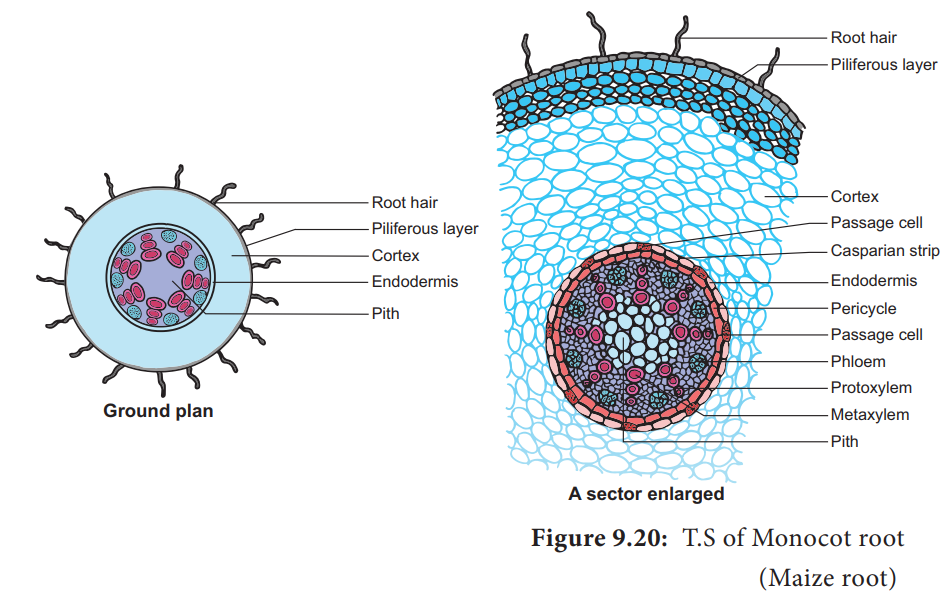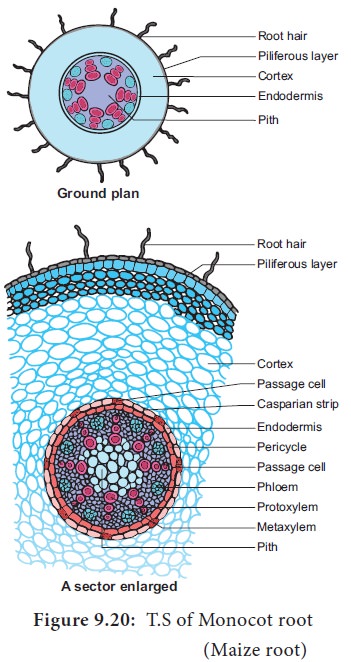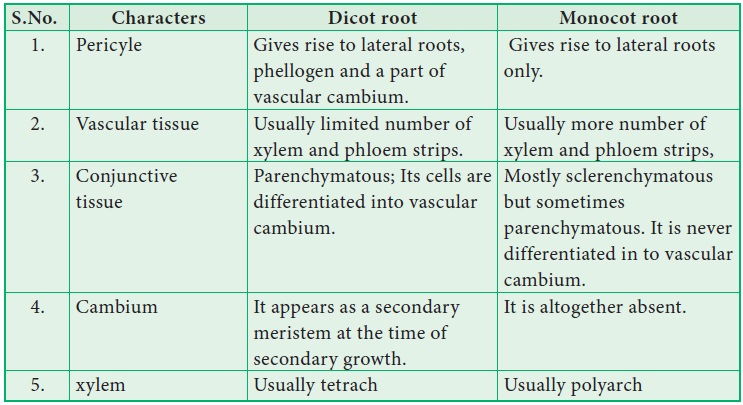Chapter: 11th Botany : Chapter 9 : Tissue and Tissue System
Primary Structure of Monocot Root-maize Root

Primary Structure of Monocot
Root-maize Root
The
transverse section of the monocot root (maize) shows the following plan of
arrangement of tissues from the periphery to the centre.
Piliferous Layer or Epiblema
The
outermost layer of the root is known as piliferous
layer. It consists of a single row of
thin-walled parenchymatous cells without any intercellular space. Epidermal
pores and cuticle are absent in the piliferous layer. Root hairs that are found
in the piliferous layers are always unicellular. They absorb water and mineral
salts from the soil. Root hairs are generally short lived. The main function of
piliferous layer is protection of the inner tissues.
Cortex
The
cortex is homogenous. i.e. the cortex is made up of only one type of tissue
called parenchyma. It consists of many layers of thin-walled parenchyma cells
with lot of intercellular spaces. The function of cortical cells is storage.
Cortical cells are generally oval or rounded in shape. Chloroplasts are absent
in the cortical cells, but they store starch. The cells are living and possess leucoplasts. The inner layer of the cortex
is endodermis. It is composed of single layer of barrel shaped parenchymatous
cells. This forms a complete ring around the stele. There is a band like
structure made of suberin and lignin present in the radial and inner
tangential walls of the endodermal cells. They are called casparian strips named after casparay
who first noted the strips. The endodermal cells, which are opposite the
protoxylem elements, are thin walled without casparian strips. These cells are
called passage cells. Their function is to transport water and dissolved salts
from the cortex to the xylem. Water cannot pass through other endodermal cells
due to casparian strips. The main function of casparian strips in the
endodermal cells is to prevent the re -entry of water into the cortex once
water entered the xylem tissue.
Stele
All the
tissues inside the endodermis comprise the stele. This includes pericycle,
vascular system and pith.
Pericycle
Pericycle
is the outermost layer of the stele and lies inner to the endodermis. It consists
of single layer of parenchymatous cells.
Vascular System
Vascular
tissues are seen in radial arrangement. The number of protoxylem groups is
many. This arrangement of xylem is called polyarch. Xylem is in exarch
condition, the tissue which is present between the xylem and the phloem, is
called conjunctive tissue. In maize, the conjunctive tissue is made up of
sclerenchymatous tissue.
Pith
The
central portion is occupied by a large pith. It consists of thin- walled
parenchyma cells with intercellular spaces. These cells are filled with
abundant starch grains.
Anatomy of Dicot and Monocot Stems
The
transverse section of the dicot stem [sunflower] shows the following plan of
arrangement of tissues from the periphery to the centre.
Epidermis
It is
protective in function and forms the outermost layer of the stem. It is a
single layer of parenchymatous rectangular cells. The cells are compactly
arranged without intercellular spaces. The outer walls of epidermal cells have
a layer called cuticle. The cuticle checks the transpiration. The cuticle is
made up of waxy substance known as cutin. Stomata may be present here and
there. Epidermal cells are living. Chloroplasts are usually absent. A large
number of multicellular hairs occur on the epidermis.
Cortex
Cortex
lies below the epidermis. The cortex is differentiated into three zones. Below
the epidermis, there are few layers of collenchyma cells. This zone is called hypodermis. It gives mechanical
strength of the Stem. These cells
are living and thickened at the corners.
Inner to
the hypodermis, a few layers of collenchyma cells are present. This zone is
called hypodermis. It gives mechanical strength to the stem. These cells are
living and thickened at the corners. Inner to the hypodermis, a few layers of
chlorenchyma cells are present with conspicuous intercellular spaces. This
region performs photosynthesis. Some resin ducts also occur here. The third
zone is made up of parenchyma cells. These cells store food materials. The
innermost layer of the cortex is called endodermis.
The cells of this layer are barrel shaped and arrange compactly without
intercellular spaces. Since starch grains are abundant in these cells, this
layer is also known a starch sheath.
This layer is morphologically homologous to the endodermis found in the root.
In most of the dicot stems, endodermis with casparian strips is not developed.
Stele
The
central part of the stem inner to the endodermis is known as stele. It consists of pericyle,
vascular bundles and pith. In dicot stem, vascular bundles are arranged in a
ring around the pith. This type of stele is called eustele.
Pericycle
Pericycle
is the layers of cells that occur between the endodermis and vascular bundles.
In the stem of sunflower (Helianthus),a
few layers of sclerenchyma cell
occur in patches outside the phloem in each vascular bundle. This patch of
sclerenchyma cell is called Bundle cap
or Hardbast. The bundle caps and the parenchyma cells between them
constitute the pericycle in the stem of sunflower.
Vascular Bundles
The
vascular bundles consist of xylem, phloem and cambium. Xylem and phloem in the
stem occur together and form the vascular bundles. These vascular bundles are Wedge shaped. They are arranged in the
form of a ring. Each vascular bundle is conjoint,
collateral, open and endarch.

Phloem
Primary
phloem lies towards the periphery. It consists of protophloem and metaphloem. Phloem
consists of sieve tubes, companion
cells and phloem parenchyma. Phloem fibres are absent in the primary phloem.
Phloem conducts organic food materials from the leaves to other parts of the
plant body.
Cambium
Cambium
consists of brick shaped and thin
walled meristematic cells. It is one to four layers in thickness. These cells
are capable of forming new cells during secondary
growth.
Xylem
Xylem
consists of xylem fibres, xylem parrenchyma vessels and tracheids. Vessels are
thick walled and arranged in a few rows.
Xylem
conducts water and minerals from the root to the other parts of the plant body.
Pith
The large
central portion of the stem is called pith.
It is composed of parenchyma cells with intercellular spaces. The pith is also
known as medulla. The pith extends
between the vascular bundles. These extensions of the pith between the vascular
bundles are called primary pith rays or primary medullary rays. Function of the
pith is storage of food.
Anatomical differences between dicot root and monocot root

Related Topics